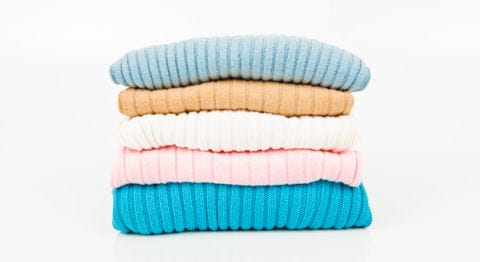What Tyes of Wool Yarn Are Okay for a Baby

Getty Images
When you think of "wool," you may remember that scratchy pullover your mom made you wear during winter years ago. But that couldn't be further from the truth. In fact, the wool family actually includes fancier knits including cashmere, mohair, and angora. So before you head to the stores, we break down everything you need to know to build the best sweater collection — ever!
Wool
Comes from: Sheep
Described simply as "wool" on fiber labels, it has a scaly exterior. While these scales protect the fiber, they can also make it feel itchy. Sheep's wool is also prone to shrinkage and felting (pilling) if it isn't cared for properly. Still, it's perfect for winter wear since it's so warm — it traps air, providing good insulation. You'll also often find that it's less expensive (and more widely available) than other knits on the market.
Lambswool
Comes from: Lamb
Not to be confused with sheep's wool, lambswool is the wool from the first shearing of a sheep when it's just several months old. The fresh wool is extra soft, smooth, and resilient, meaning it won't wrinkle as easily. It's rarer since you can only shear a baby sheep's virgin hair once, thus it's more expensive.
Merino
Comes from: Merino sheep
Compared to sheep's wool, merino wool is finer and has smaller scales, so it's not as bulky. And, because it's full of finer fibers, there's less pilling and shrinkage. Merino is great at temperature regulation (keeping you warm when it's cold and cool when it's hot), so you'll find it year round. It's also popping up a lot in athletic gear. Yes, you can even rock wool during your workout.
Cashmere
Comes from: Cashmere goat
Often considered the most luxurious type of wool, cashmere is a fine fiber that is stronger, lighter, less itchy, and more durable than traditional sheep's wool. It provides excellent insulation yet can be worn in the spring and you won't overheat. Because it's rare and harder to produce than traditional wool, it's more expensive. One reason: Sometimes it takes the fibers from two cashmere goats to make just one sweater.
Mohair
Comes from: Angora goat
It has a silk-like texture, so it's very soft and shiny, but still has a lot of insulation to keep you warm. Unlike traditional wool, mohair doesn't have many scales, so it's smoother. It's also strong and resilient, so it won't wrinkle easily.
Angora
Comes from: Angora rabbit
Not to be confused with the goat, Angora rabbit fibers are hollow, meaning that while they are lightweight and fluffy, they still offer great insulation. In fact, they are much warmer than traditional wool and perfect for colder climates. However, because the fibers are more fragile you'll often find them as accents — perhaps on a collar only — or blended with other fibers to make it stronger. Angora is also rare and requires a lot of work to produce, so it's generally more expensive than other varieties.
Alpaca
Comes from: Alpaca (a llama-like mammal)
Alpaca wool is lightweight, soft, silky, and durable. It's similar to traditional sheep's wool but is warmer and less scaly. (Read: not as itchy.) There are two different types of Alpaca: Huacaya, which you'll find in knits, and Suri, which is silkier and often used in woven garments like suits. Unlike other types of wool, it's naturally available in a wide variety of colors (though it can still be dyed).
TELL US: Which is your favorite type of wool?
Lexie Sachs is a textiles product analyst for the Good Housekeeping Research Institute.
More Winter Shopping Tips:
• How to Shop for Cashmere Like a Pro
• 5 Rules for Buying Winter Boots
•Your Biggest Tights Problems — Solved
Photo credit: Getty Images
Lexie Sachs, Good Housekeeping Institute Textiles Director Lexie Sachs earned her Bachelor of Science degree in Fiber Science from Cornell University, and she researches, tests and reports on fabric-based products ranging from sheets, mattresses and towels to bras, fitness apparel and other clothing.
This content is created and maintained by a third party, and imported onto this page to help users provide their email addresses. You may be able to find more information about this and similar content at piano.io
What Tyes of Wool Yarn Are Okay for a Baby
Source: https://www.goodhousekeeping.com/beauty/fashion/tips/a26326/wool-buying-guide/
0 Response to "What Tyes of Wool Yarn Are Okay for a Baby"
Post a Comment